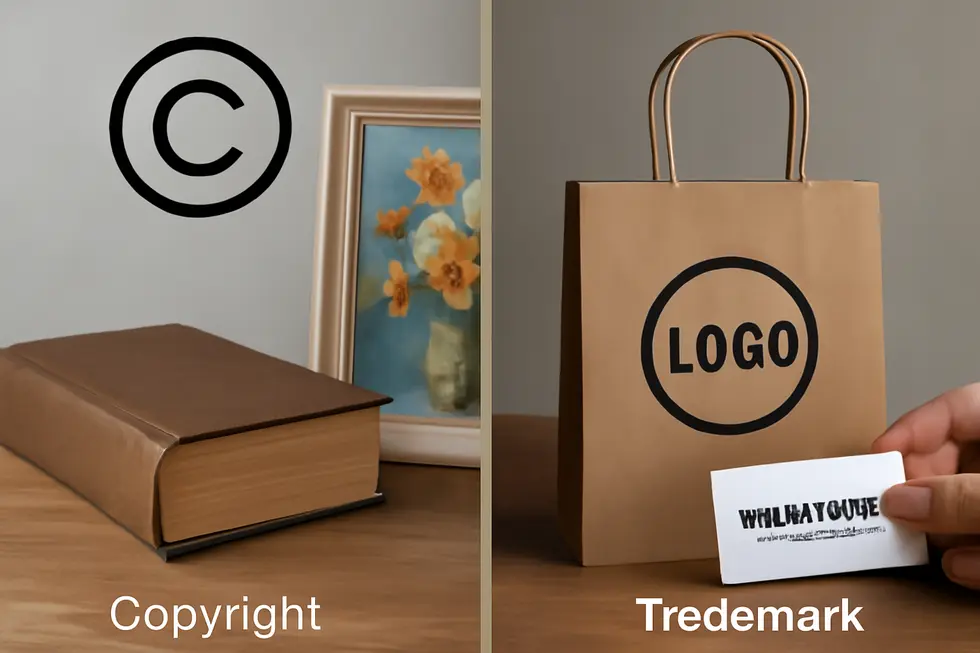Introduction
Building a strong brand is key to business success, but understanding how to protect it legally can be confusing. Many business owners mistakenly believe that copyright protects their brand elements like names and logos, but this is not the case. Copyright law covers original works of authorship, whereas brand identifiers such as names, logos, and slogans fall under trademark protection. To safeguard what makes your business unique, it’s critical to use the right legal tools. This guide clarifies why you cannot copyright your brand and explains the trademark registration process that truly secures your brand identity. We will explore the differences between copyright and trademark protections, detail how to register a trademark, and explain how to maintain and monitor your trademark rights over time. Additionally, we will debunk common misconceptions surrounding copyright and brand protection to empower you with clear, actionable knowledge.
Tables of Contents
Chapter 1: Understanding Why You Cannot Copyright Your Brand
- Why Copyright Law Doesn’t Protect Your Brand Identity: The Crucial Differences From Trademark Law
- Why Brand Names, Logos, and Slogans Are Guarded by Trademark, Not Copyright
- Why Trademark Registration, Not Copyright, Secures Your Brand Identity
Chapter 2: How to Legally Protect Your Brand Through Trademark Registration
- Mastering the Trademark Search and Application Process for Solid Brand Protection
- Mastering the Trademark Registration Journey: From Search to Overcoming Challenges
- Maximizing Your Brand’s Legal Shield: Navigating Trademark Registration for Complete Protection
Chapter 3: Detailed Process of Trademark Registration to Copyright Your Brand
- Mastering the Trademark Journey: From Search to Registration for Strong Brand Protection
- From Publication to Protection: Key Steps in Trademark Opposition and Maintenance for Brand Security
- Combining Trademark and Copyright Protections: A Cohesive Strategy to Secure Your Brand Identity
Chapter 4: Differences Between Copyright and Trademark in Protecting Your Brand
- Legal and Technological Foundations That Define Copyright and Trademark Protections for Your Brand
- Economic Impact of Trademark vs. Copyright Protection on Brand Value and Growth
- How Trademark and Copyright Diverge in Shaping Brand Trust and Market Presence
Chapter 5: Maintaining and Monitoring Trademark Protection for Your Brand
- Comprehensive Lifecycle Management: Sustaining and Safeguarding Your Trademark’s Vitality
- Ensuring Brand Integrity Through Compliance, Audits, and Enforcement
- Harnessing Integrated Legal and Technological Approaches to Safeguard Your Trademark
Chapter 6: Common Misconceptions and Legal Insights on Copyrighting Your Brand
- Demystifying Brand Protection: Why Copyright and Trademark Serve Different Roles
- Navigating Trademark Registration: Legal Steps and Enforcement Realities for Protecting Your Brand Identity
- How Trademark Misunderstandings Threaten Your Brand’s Economic Value and Market Position
Chapter 1: Understanding Why You Cannot Copyright Your Brand

1. Why Copyright Law Doesn’t Protect Your Brand Identity: The Crucial Differences From Trademark Law
Copyright law and trademark law serve distinctly different purposes when it comes to protecting creations and brand identities. Copyright safeguards original works of creative expression—like books, music, or artwork—that are fixed in a tangible form. However, brand identifiers such as business names, logos, and slogans do not fall under copyright protection because they are not considered original creative works in the legal sense. Instead, these elements are commercial symbols used to distinguish the source of goods or services and are protected by trademark law.
Trademarks focus on preventing consumer confusion by granting exclusive rights to distinctive marks used in commerce. Unlike copyright, which protects creative content, trademark law protects your brand’s identity and reputation in the marketplace. This legal framework ensures your brand elements are linked directly to your offerings, giving you the authority to stop others from using confusingly similar marks.
Understanding this distinction is vital for correctly protecting your brand. Attempting to copyright a brand name or logo ignores that these are identifiers — not creative works — and leaves your brand vulnerable. For more information on protecting brand identifiers through trademarks, exploring resources on trademark protection for business names and logos can provide valuable guidance.
2. Why Brand Names, Logos, and Slogans Are Guarded by Trademark, Not Copyright
Brand elements such as names, logos, and slogans cannot be copyrighted because copyright law requires originality and creativity that these elements lack as standalone marks. Copyright protects artistic and literary works fixed in a tangible medium, but it excludes “words and short phrases,” including business names and titles. This exclusion stems from the idea/expression dichotomy, which distinguishes protectable creative expression from unprotectable ideas or common terms. Even stylized fonts or designs often fail copyright’s originality threshold because they do not qualify as distinct artistic works.
Instead, trademarks serve as the proper legal tool to protect brand identifiers. Trademark law grants exclusive rights to use words, phrases, logos, or symbols that distinguish goods or services in commerce. This protection prevents others from causing confusion or diluting a brand’s distinctiveness. However, trademarks require active commercial use and legal maintenance to remain valid, and generic or descriptive terms cannot be protected.
For a deeper understanding of why copyright does not cover brand elements and how trademarks fill this gap, see this detailed discussion on can you copyright a word?.
3. Why Trademark Registration, Not Copyright, Secures Your Brand Identity
Copyright law protects original artistic and literary works such as books, music, and artwork fixed in a tangible form, but it does not extend to brand identifiers like business names, logos, or slogans. These crucial elements that define your brand require protection under trademark law, which is specifically designed to safeguard marks used in commerce to identify and distinguish goods or services. Unlike copyright, trademark registration grants you exclusive, nationwide rights to use your brand elements, providing a strong legal foundation against infringement and consumer confusion. This protection is potentially indefinite, so long as you actively use and maintain your trademark. Registering a trademark involves careful searching for existing marks, filing with a government authority, and ongoing monitoring to preserve your rights. Without it, your brand remains vulnerable to unauthorized use, which can dilute your identity and harm your business reputation. To fully secure your brand, trademark registration is not just recommended—it is essential. For more details on protecting your business name and logo, explore this resource on trademark protection.
Chapter 2: How to Legally Protect Your Brand Through Trademark Registration

1. Mastering the Trademark Search and Application Process for Solid Brand Protection
Protecting your brand starts with a meticulous trademark search to ensure your mark is distinctive and legally registrable. This foundational step involves exploring domestic databases like the USPTO’s TESS and, if relevant, international databases to identify any identical or similar trademarks. Such comprehensive clearance helps avoid costly conflicts and application rejections based on likelihood of confusion. Once confident the mark is unique, preparation of the application must be handled with precision. Selecting the accurate trademark classes tailored to your goods or services defines the legal scope of protection and is crucial for enforceability. Crafting detailed yet balanced descriptions of your goods or services alongside real-world specimens—such as packaging or website images—demonstrates actual commercial use. Providing exact owner information and the precise mark format ensures the application’s clarity and validity. Filing electronically via the USPTO’s TEAS, accompanied by appropriate fees, initiates the registration process, which may span several months. Ongoing attention to official correspondence and readiness to address any office actions or oppositions helps navigate potential obstacles. Successful registration grants you enforceable rights to safeguard your brand identity and prevents infringement. Engaging with expert trademark counsel can greatly enhance your application’s success and strengthen your brand’s legal foundation. For more detailed guidance, visit USPTO trademark resources. Learn more about strategic trademark protection at trademark protection for business name and logo.
2. Mastering the Trademark Registration Journey: From Search to Overcoming Challenges
Protecting your brand through trademark registration begins with a meticulous and strategic approach to searching, filing, and defending your mark. Before submitting an application, conducting a comprehensive trademark search using databases like the USPTO’s TESS is essential to identify existing marks that could block registration. This upfront due diligence helps avoid refusals based on similarity or likelihood of confusion. When filing, precise application preparation is critical; your submission must clearly describe the mark, ownership, and the goods or services it represents. Payment and identity verification complete this online process.
After filing, a trademark examiner reviews the application for compliance. If issues arise, such as potential conflicts or technical inaccuracies, you’ll receive an Office Action requiring your response. Addressing these promptly and thoroughly is necessary to keep your application active. Additionally, third parties may oppose your registration, initiating disputes that require careful legal handling to defend your brand’s rights.
Successful registration grants exclusive use of your trademark nationwide, contingent on ongoing maintenance filings to preserve enforceability. Navigating this complex path benefits from professional guidance to maximize your chances of approval and to manage challenges effectively. For more details on securing your brand identifiers, explore trademark protection for business name and logos.
Begin early, remain diligent through this 8 to 18 month process, and safeguard your brand identity with confidence by mastering each stage of trademark registration.
For official filings and detailed instructions, visit the USPTO Trademark Center.
3. Maximizing Your Brand’s Legal Shield: Navigating Trademark Registration for Complete Protection
Protecting your brand through trademark registration requires a strategic process that ensures your brand’s distinct identity receives robust legal coverage. Start by performing a thorough trademark search to confirm that your proposed brand name, logo, or slogan does not conflict with existing trademarks. This crucial step reduces the risk of application rejection or costly disputes. Next, prepare and file an accurate application with the trademark office, clearly detailing the owner, the mark, and the associated goods or services. During the examination process, actively monitor your application’s progress and respond promptly to any office actions or objections.
Once registered, your trademark grants exclusive rights that legally protect your brand against unauthorized use, empowering you to prevent infringement and potential dilution. Maintaining these rights requires diligent renewal filings and ongoing monitoring of the marketplace for potential misuse. Swift enforcement through cease-and-desist communications or legal means is essential to uphold your brand’s integrity. Leveraging your registered trademark enhances your business’s value, deters competitors, and strengthens your position in licensing or partnership negotiations.
For more information on protecting business names and logos, visit trademark protection for business names and logos.
Chapter 3: Detailed Process of Trademark Registration to Copyright Your Brand

1. Mastering the Trademark Journey: From Search to Registration for Strong Brand Protection
Navigating the trademark registration process is essential for securing your brand’s unique identity and exclusive legal rights. It starts with a comprehensive trademark search using databases like the USPTO’s Trademark Electronic Search System (TESS) to ensure your mark is not already in use or confusingly similar to existing ones. This preliminary step reduces risks of rejection or future disputes. Once confirmed, preparing an accurate and thorough application is crucial. This involves selecting a distinctive mark, correctly classifying your goods or services, and providing details such as ownership and evidence of the mark’s commercial use. Filing is done electronically through authorized systems like the USPTO’s Trademark Electronic Application System (TEAS), including payment of fees based on the number of classes covered.
After submission, a trademark examiner reviews your application for compliance and potential conflicts. If issues arise, Office Actions require timely responses to clarify or amend the application. Approved marks are then published for opposition, allowing others to challenge the registration. When uncontested, final registration grants you nationwide exclusive rights, preventing misuse or confusion. Maintaining your trademark post-registration through renewals and enforcement is equally vital to sustain protection. For those seeking expert insights, detailed guidance is available on how to trademark a business name, providing practical steps for every stage of this critical process.
For additional reference, visit how to trademark a business name and explore trademark protection strategies at trademark protection business name logo.
2. From Publication to Protection: Key Steps in Trademark Opposition and Maintenance for Brand Security
Trademark registration is a multi-phase process critical for securing exclusive rights to your brand’s identifiers. After filing and examination, marks approved by the USPTO enter the publication stage in the Official Gazette. This public listing opens a 30-day opposition period, during which third parties can challenge the registration if they believe it infringes their existing rights. The opposition process is formal and strictly timed, handled by the Trademark Trial and Appeal Board, ensuring fair consideration of conflicting claims. If no opposition arises or disputes are resolved favorably, the USPTO officially registers the mark, granting nationwide protection.
However, registration is not the final step. Maintaining your trademark requires diligence—filing declarations of continued use between the 5th and 6th years and renewals every ten years is mandatory to preserve rights. Failure to comply can result in cancellation and loss of legal protections. Beyond paperwork, ongoing vigilance to monitor unauthorized use helps prevent infringement or dilution of your brand’s distinctiveness. This comprehensive approach ensures your trademark remains a powerful, enforceable asset that safeguards your brand identity effectively.
For further insights into protecting your business name and logo through trademarks, see trademark protection business name logo.
More detailed guidance on these stages is available at Masterly Legal Solutions overview.
3. Combining Trademark and Copyright Protections: A Cohesive Strategy to Secure Your Brand Identity
Securing your brand’s identity requires a strategic blend of trademark and copyright protections to cover all legal facets. The trademark registration process begins with a thorough search to confirm your brand elements—names, logos, slogans—are unique and free of conflicts. Filing a precise application with details about ownership, the mark, and associated goods or services is crucial to avoid delays. Responding effectively to any objections or oppositions maintains momentum toward registration. After securing a trademark, ongoing monitoring for infringement and timely renewals safeguard your exclusive rights.
While trademarks protect the commercial identity, copyright complements this by protecting original creative expressions tied to your brand, such as artistic logos, website content, and packaging designs. Registering copyrights for these works establishes formal proof and stronger enforcement against unauthorized use. Together, these protections create a comprehensive legal framework that guards both the distinctive identifiers and the creative content underpinning your brand.
This integrated approach not only prevents confusing similarities in commerce but also fortifies the unique artistic aspects that define your brand’s character. For an optimized protection strategy tailored to your brand’s assets, seeking advice from intellectual property professionals is highly recommended. Learn more about strategic brand protection in our guide to trademark protection for business names and logos.
Chapter 4: Differences Between Copyright and Trademark in Protecting Your Brand

1. Legal and Technological Foundations That Define Copyright and Trademark Protections for Your Brand
The fundamental legal and technological distinctions between copyright and trademark determine how each protects your brand. Copyright automatically secures original creative works like texts, art, and software when they are fixed in a tangible form. Its protection centers on the expression of ideas, not the ideas themselves, lasting through the creator’s lifetime plus 70 years. Technologically, copyright safeguards the creative content, such as the specific arrangement of words or code, ensuring that unauthorized copying or distribution is prohibited.
Conversely, trademarks require a formal registration process with authorities like the USPTO to protect brand identifiers—names, logos, slogans—that serve as commercial source indicators. Trademark protection aims to prevent consumer confusion by guaranteeing your brand’s unique identity in the marketplace, with potential indefinite duration as long as the mark is actively used and properly maintained. Technologically, trademarks protect symbols and names displayed across media and commerce.
While copyright focuses on creators’ rights over artistic works, trademark law prioritizes consumer perception and market clarity. This distinction underscores why trademarks, not copyrights, are the proper tool for exclusive brand identity protection. For more details on securing your brand identifiers, explore strategies for trademark protection of business names and logos.
2. Economic Impact of Trademark vs. Copyright Protection on Brand Value and Growth
Trademark protection uniquely enhances the economic strength of a brand by securing exclusive rights to names, logos, and symbols that distinguish goods or services. Unlike copyright, which protects original creative works without covering brand identifiers, trademarks support indefinite protection as long as they are actively used and properly renewed. This perpetual protection directly contributes to sustained brand equity, increasing a company’s valuation and attractiveness to investors. Registered trademarks enable businesses to generate licensing income and expand through franchising, which amplifies revenue streams and market reach.
In contrast, copyright safeguards artistic or literary content but does not prevent competitors from using similar brand marks in commerce. This gap limits copyright’s economic influence on brand exclusivity and consumer recognition, ultimately restricting its role in building a commercially valuable identity. Without trademark registration, brands risk diminished value and lost opportunities for monetization.
By investing in trademark registration, businesses secure a strategic economic advantage, fostering consumer trust and competitive positioning. This proactive protection safeguards future growth potential and maximizes returns on branding efforts.
For more detailed economic insights on intellectual property protection, see copyright definition economics for business and analyses at patentpc.com.
3. How Trademark and Copyright Diverge in Shaping Brand Trust and Market Presence
Trademark and copyright protections impact brands in fundamentally different ways, shaping consumer perception and competitive dynamics. Trademarks safeguard the unique elements that signal a brand’s origin—names, logos, and slogans—creating clear markers that build consumer trust and reduce confusion in the marketplace. This protection fosters fair competition by allowing brands to maintain distinct identities over time through potentially indefinite renewal, reinforcing credibility with customers, partners, and platforms alike. In contrast, copyright secures original creative works such as artistic content or written materials, which enhance a brand’s cultural and aesthetic appeal but do not legally prevent others from using similar business identifiers in commerce. Consequently, relying solely on copyright leaves a gap in market protection that can undermine exclusive brand recognition and invite confusion or infringement. Misunderstanding these differences risks legal vulnerability and dilution of brand equity. Successful brand protection strategy balances copyright’s role in safeguarding creative assets while prioritizing trademark registration to firmly establish and defend brand identity. This synergy allows brands to thrive by protecting both their creative expression and their commercial distinctiveness. For a detailed guide on effectively protecting your business logo and name, see trademark protection for business name and logo.
Chapter 5: Maintaining and Monitoring Trademark Protection for Your Brand

1. Comprehensive Lifecycle Management: Sustaining and Safeguarding Your Trademark’s Vitality
Establishing a robust lifecycle management system is essential for sustaining your trademark’s protection and ensuring your brand’s longevity. This process begins with thorough clearance searches to avoid conflicting marks and continues through vigilant application monitoring, responding promptly to any regulatory feedback. Once registered, trademarks demand continual surveillance to detect unauthorized use or infringement, which is critical to preserving exclusivity and preventing dilution of your brand. Renewals are equally vital, requiring punctual filings and proof of ongoing commercial use to uphold rights and prevent claims of abandonment. As your business evolves, updating trademark registrations to reflect new logos, slogans, or expanded product lines helps maintain comprehensive coverage. If licensing your trademark, instituting strict quality control safeguards your brand’s reputation and prevents rights erosion through inconsistent use. Integrating advanced tools, including AI-driven monitoring platforms, enhances this dynamic management, making protection more efficient and proactive. By embedding these practices into your trademark strategy, you align legal protection with your business growth, minimizing risks while maximizing your brand’s value and enforceability. For a detailed guide on lifecycle management tailored to evolving business models, see this comprehensive overview.
2. Ensuring Brand Integrity Through Compliance, Audits, and Enforcement
Maintaining robust trademark protection for your brand depends heavily on strict compliance, ongoing audits, and decisive enforcement actions. Compliance begins with clear licensing agreements that define precise quality standards and trademark usage guidelines. These agreements prevent dilution by ensuring that any use of your trademark aligns with your brand’s values and legal requirements. Regular audits serve as essential checkpoints to verify that licensees uphold these standards, mitigating risks such as “naked licensing” which can jeopardize your trademark rights if control over its use is lost.
Equally important is maintaining unwavering quality control, which protects your brand’s goodwill and sustains consumer trust. Post-registration, active monitoring is vital to detect unauthorized uses or conflicting marks early. Employing trademark watch services and market surveillance provides documented evidence crucial for enforcing your rights. When infringement occurs, swift enforcement—including cease-and-desist letters or legal action—safeguards your brand and deters future violations.
Working alongside intellectual property counsel helps align your enforcement strategies and audits with evolving legal standards and business goals. This comprehensive approach fortifies your trademark’s legal standing and preserves the distinctiveness of your brand in the marketplace. For further insight on monitoring compliance in trademark licensing, explore detailed guidance on compliance monitoring.
3. Harnessing Integrated Legal and Technological Approaches to Safeguard Your Trademark
Harnessing Integrated Legal and Technological Approaches to Safeguard Your Trademark
Protecting your brand’s trademark requires a strategic combination of legal vigilance and technological innovation. Automated trademark monitoring services scan global databases regularly, detecting identical or similar marks that risk infringement. These platforms use class and regional analysis to provide timely alerts, enabling swift legal responses such as oppositions or enforcement actions. Complementing this, brand protection software extends monitoring across the digital landscape, identifying counterfeit products, domain impersonations, and unauthorized logo uses by employing advanced image recognition and web crawling technologies.
Legal enforcement remains central: federal registration solidifies exclusive rights, but active maintenance demands vigilance to prevent dilution or unauthorized use. This includes filing oppositions, sending cease-and-desist letters, or pursuing litigation when necessary. Supplementary techniques like Google Alerts and reverse image searches enhance detection of misuse in content or imagery.
By integrating these technological tools with robust legal mechanisms, trademark owners create a dynamic defense system that proactively preserves brand integrity and combats infringement in an evolving marketplace. Learn more about the legal foundations for securing your brand at trademark protection for business name and logo.
For an in-depth guide on legal steps and enforcement strategies, see the comprehensive overview at UpCounsel.
Chapter 6: Common Misconceptions and Legal Insights on Copyrighting Your Brand

1. Demystifying Brand Protection: Why Copyright and Trademark Serve Different Roles
Copyright and trademark frequently get mixed up, but they protect fundamentally different aspects of your brand. Copyright safeguards original artistic or literary works fixed in a tangible medium—such as books, music, or artwork. However, it does not extend to brand identifiers like business names, logos, or slogans since these are often short phrases or titles lacking the originality required for copyright. In contrast, trademark protection specifically covers these elements by guarding distinctive names, logos, and slogans that uniquely identify your goods or services in commerce. This protection prevents consumer confusion and secures your exclusive rights to the brand identity you build. Unlike copyright, which arises automatically upon creation, trademark rights stem from actual use in commerce and are strengthened by federal registration, which provides robust legal enforcement nationwide. Moreover, trademark protection can last indefinitely as long as you continue using the mark and maintain renewals. Confusing these protections can leave key brand elements unprotected or vulnerable to infringement. For guidance on properly safeguarding your brand identity, understanding these distinct intellectual property tools is essential. For more on protecting your brand identifiers through trademark law, see trademark protection for business name and logo.
2. Navigating Trademark Registration: Legal Steps and Enforcement Realities for Protecting Your Brand Identity
Many misunderstandings surround the idea of protecting a brand through copyright versus trademark. Notably, brands cannot claim copyrights on names or logos but must rely on trademark law. Trademark registration demands a clear process: conducting a detailed search to avoid conflicts, selecting a distinctive mark, and properly classifying goods or services before submitting an application to the USPTO. This application undergoes examination, public opposition, and finally registration if uncontested.
However, registration alone does not guarantee full protection. Trademark owners must vigilantly monitor the marketplace to enforce their rights, as legal success often hinges on proving the likelihood of consumer confusion about the source of goods or services. This nuanced standard means businesses need strategic selection and active management of their marks. Moreover, simply registering a business name does not confer exclusive brand rights, exposing unregistered marks to infringement risks and potential costly rebranding.
Understanding these legal realities ensures brand owners avoid pitfalls like neglecting trademark searches, choosing generic marks, or skipping renewal filings. By embracing trademark registration and enforcement as ongoing efforts, brands secure meaningful, lasting protection tailored specifically to their identity. For more on this process, see the detailed coverage on trademark protection for business names and logos. External insights on enforcement challenges are further detailed at UpCounsel.
3. How Trademark Misunderstandings Threaten Your Brand’s Economic Value and Market Position
Trademark confusion often stems from the mistaken belief that copyright covers brand elements like logos or business names. This misperception can leave critical parts of a brand unprotected, exposing businesses to costly legal disputes, loss of consumer trust, and forced rebranding. Unlike copyright, which protects original creative works, trademarks safeguard tangible brand identifiers that distinguish products and services in commerce. However, trademark registration is not automatic or unconditional; it requires diligent searching, selecting distinctive marks, and actively enforcing rights to maintain exclusivity. Furthermore, it is common to confuse registering a business name with securing trademark rights, though these serve different legal functions. Economically, trademarks have become invaluable intangible assets, underpinning consumer recognition and competitive advantage. When trademark protection is overlooked or improperly managed, brands face significant risks including market dilution and erosion of goodwill, which can severely harm growth and reputation. Adhering to proper trademark practices ensures a brand’s legal security and enhances its economic resilience. For deeper insights on protecting your brand identity beyond copyright, consider exploring trademark protection for business names and logos. External legal perspectives emphasize that understanding and complying with trademark law is essential to preserving brand equity and fostering healthy market competition.
UpCounsel on trademark law and brand protection offers comprehensive guidance supporting these points.
Final thoughts
Protecting your brand is crucial to ensuring the long-term success and uniqueness of your business. While it is common to confuse copyright protection with securing brand elements like names and logos, the reality is that trademark registration is the proper legal tool that offers robust and lasting protection. By understanding why copyright does not cover brand identifiers, learning the trademark registration process, and maintaining your trademark rights, you can safeguard your brand from infringement and dilution. Clearing misconceptions fuels smarter decisions that preserve your brand’s value. Equip yourself with the right knowledge and legal protections to confidently build and defend your brand identity in today’s competitive marketplace.
Your IP is the foundation of your success – let’s protect it together before it’s too late. We can’t wait to help you turn your ideas into legally secured assets.
About us
undefined


